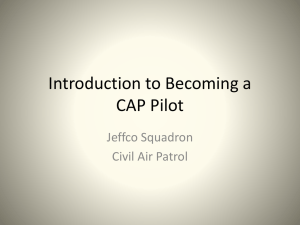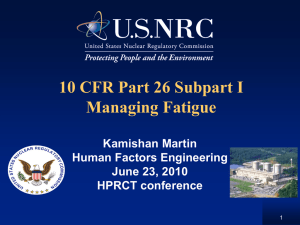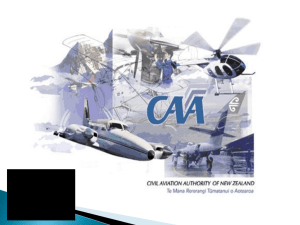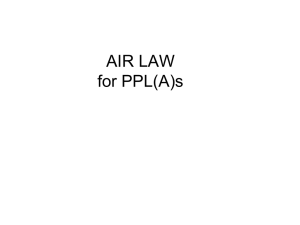Human Factors in Gliding
advertisement
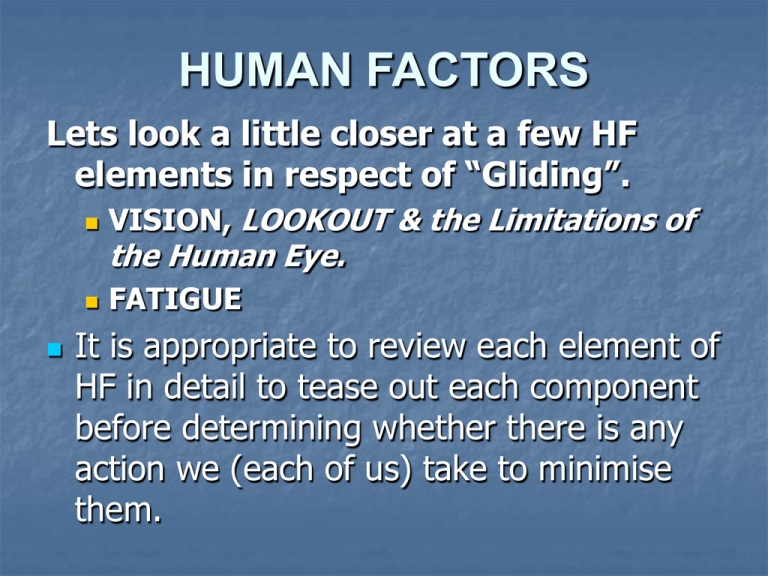
HUMAN FACTORS Lets look a little closer at a few HF elements in respect of “Gliding”. VISION, LOOKOUT & the Limitations of the Human Eye. FATIGUE It is appropriate to review each element of HF in detail to tease out each component before determining whether there is any action we (each of us) take to minimise them. HUMAN FACTORS VISION, LOOKOUT & the Limitations of the Human Eye. You may LOOK, but not necessarily see, for a number of reasons. BUT REMEMBER, LOOKING and not seeing is the same as not Looking ! Understanding the limitations of the Human Eye (and the other bodily systems), identifies some HF aspects of “Lookout”. HUMAN FACTORS Vision – is the primary source of information for a pilot - be it for aircraft attitude, position or physical hazards (other aircraft). Vital that Pilot’s know the quality and any short-comings of their own vision. Important that Instructor’s and Coaches effectively train a pilot how to best utilise vision to maintain maximum safety. HUMAN FACTORS Vision involves both the internal and external environment of the aircraft. Inside - to interpret flight instruments, flight controls and aircraft systems, maps & charts. Externally - to observe and interpret weather, terrain, aircraft attitude and position, and to see other airspace users. HUMAN FACTORS Lookout involves thorough scanning of all the sky, regularly, to locate other airspace users. THIS REQUIRES - GOOD VISION. - UNDERSTANDING THE LIMITATIONS OF THE HUMAN VISION SYSTEM. - SYSTEMATIC SCANNING TECHNIQUES - Correct interpretation of what is seen. HUMAN FACTORS LOOKOUT must involve at least two pilots if there are two aircraft in the immediate vicinity. Lookout can only be successful as a “seeand-avoid” method while looking out – that is looking outside the cockpit. If one pilot is pre-occupied with maps, charts, Glide Computer, PDA etc, he can’t be looking out AND the safety margin is reduced. HUMAN FACTORS Some Eye Limitations Focus - requires time, something to focus on. Quality of Sight, How good is your eye-sight ?. How How How How many people many people many people do you know know they have poor eye-sight ?. know they have good eye-sight ?. don’t know ? you have or don’t have good sight. Cant read the “fine print”. Cant read the car in fronts number plate at 25 metres. Regular formal eye check. How many require / carry corrective lenses. HUMAN FACTORS Some Eye Limitations (Cont’d) Age – as we age, the quality of our vision changes. Blind Spots. Alcohol effects and impacts - spatial disorientation. Fatigue HUMAN FACTORS Other Limitations. Moving object vs stationary object. Canopy condition, cleanliness, A/C structure. Natural background Object colour, available light, glare, contrast etc Location – how many pilot’s increase their scan near the circuit area. Alerted See & Avoid, Situational Awareness. HUMAN FACTORS The factors affecting lookout are not all errors or poor airmanship, some are limitations of the human visual and information processing systems, present to various degrees in us all. Effective training can improve the quality of a lookout technique. We can address some of the “HF” aspects to minimise their impact. HUMAN FACTORS “LOOKOUT” HF’s. It takes time to SEE, 0.1 seconds time to recognise the object, 1 second time to recognise collision risk, 5 seconds time to make a decision, 4 seconds time to react, 0.5 seconds lag in reacting (A/C etc) 2 seconds - 12.6 seconds, once you have seen the object HUMAN FACTORS How can we minimise the HF influence? - Only we, as individual pilot’s, can influence “HF” in gliding. - We should try to influence our peers. It is vital that every “link in the chain” fully contributes all that is possible and necessary in every respect to minimise HF. This requires knowledge (through training, experience, etc), interest and attention to detail. HUMAN FACTORS Our Responsibility “It doesn’t matter how many Rules, Regulations, Procedures, Advisory Circulars, Mandatory Directives, Compulsory Training Courses or Voluntary Training Courses are provided, unless we, in the end it’s up to us - the pilot’s - as individuals. HUMAN FACTORS Consciously make the time available to scan – the majority of a pilot’s time should be spent LOOKING OUT. Have an ORGANISED cockpit. Arrange the cockpit workload accordingly. Make the appropriate radio calls, on the appropriate frequency. Don’t plan to arrive at unexpected points in the circuit – fly a circuit if possible. HUMAN FACTORS To minimise the HF influence for LOOKOUT Focus – Understand the limitations of the eye. - Develop a systematic scan pattern. - Allow time for the eye to focus. - Make the eye to focus on a distant object before commencing a scan. Re-focus. Know the quality of your eye-sight. - Have a regular eye-test. - If prescribed, wear corrective lenses. - Keep them clean. - Carry a spare pair (in reach in the cockpit). HUMAN FACTORS Ensure the canopy is clean. Appreciate the effects of the background, the available light, object colour and contrast. Increase the scan in and near the circuit area. Use the radio for “Alerted See & Avoid” and to build “Situational Awareness”. HUMAN FACTORS FATIGUE Reasons for the onset of Fatigue Illness Exertion Excessive workload (cumulative effect). Poor Rest, Sleep ( “ “ ). Alcohol event ( “ “ ). Stress Boredom HUMAN FACTORS Fatigue likely to be promoted by; - Excessively hot weather. - Hypoxia. - Dehydration. - Boredom. HUMAN FACTORS Signs of Fatigue More likely to occur later in a flight / the day, when you need to be alert and attentive. Missing critical items, Checks, etc SCAN failure, Radio Calls, Track keeping, Taking a drink or food, Airspace violation, Geographically challenged. Taking shortcuts, slow to react. Can’t remember a very recent (brief) period. Becoming drowsey. HUMAN FACTORS FATIGUE Mitigators “Identifying FATIGUE is the challenge” Drink water or fluid, take food. Take a series of deep breaths. If oxygen deprived, consider using oxygen or descending. Don’t take shortcuts. Adequate Sleep, Rest. HUMAN FACTORS FATIGUE Mitigators Avoiding alcohol before flying. Becoming well following an illness before flying.

